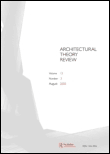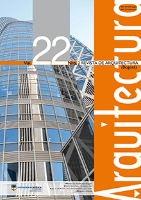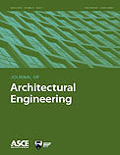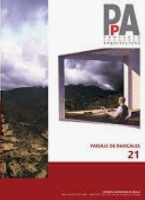
Architectural Science Review
Scope & Guideline
Advancing architectural knowledge for a sustainable future.
Introduction
Aims and Scopes
- Sustainable Design and Energy Efficiency:
The journal focuses on sustainable architectural practices, exploring energy-efficient designs, renewable energy integration, and innovative materials that contribute to reducing the ecological footprint of buildings. - User-Centric Design and Human Experience:
Research published often investigates how architectural elements influence human behavior, emotional responses, and overall well-being, emphasizing the importance of user experience in architectural design. - Technological Integration in Architecture:
The journal highlights the role of advanced technologies such as AI, machine learning, and digital tools in architectural practice, advocating for innovative approaches to design, construction, and building management. - Thermal and Acoustic Comfort:
A consistent theme in the journal is the analysis of thermal and acoustic performance in various built environments, focusing on how these factors affect occupant comfort and health. - Cultural and Historical Context in Design:
The journal promotes studies that address the cultural and historical dimensions of architecture, encouraging the integration of local traditions and practices into contemporary architectural solutions. - Architectural Education and Practice:
Research related to architectural education, including teaching methodologies and the disconnect between design education and practice, is a significant focus, aiming to improve training for future architects.
Trending and Emerging
- Smart Technologies and Automation:
There is a rising trend in the adoption of smart technologies and automation within architectural design, focusing on how these innovations enhance building performance and user interaction. - Impact of Climate Change on Architecture:
Research increasingly addresses climate change's effects on architectural design, including the development of resilient buildings and adaptive strategies that respond to shifting environmental conditions. - Mental Health and Well-Being in Built Environments:
A growing body of work is dedicated to understanding how design influences mental health and well-being, emphasizing the importance of creating supportive and healing environments. - Mixed-Methods Research Approaches:
An emerging trend is the use of mixed-methods approaches, combining qualitative and quantitative research to provide a more comprehensive understanding of user experiences and architectural performance. - Integration of Neuroscience in Architecture:
There is a notable increase in research exploring the intersection of neuroscience and architecture, focusing on how environmental factors affect cognitive processes and human emotions. - Adaptive Reuse and Sustainability:
The trend towards adaptive reuse of existing structures, coupled with sustainability principles, is gaining prominence as architects seek to balance preservation with modern functionality.
Declining or Waning
- Traditional Construction Techniques:
There has been a decrease in research centered on traditional construction methods as the focus shifts towards modern technologies and materials, reflecting a growing trend towards innovation and sustainability. - Generalized Design Theories:
While foundational design theories remain important, there is a decline in the publication of generalized theoretical discussions, with a preference for applied research that addresses specific challenges in architectural practice. - Purely Aesthetic Studies:
Research that solely emphasizes aesthetic considerations without addressing functional or environmental performance has become less common, as the field increasingly prioritizes holistic approaches to design. - Historical Architectural Styles:
Papers focusing exclusively on historical styles or preservation without a contemporary application or relevance to current architectural practices are appearing less frequently, indicating a shift towards integrating history with modern design. - Non-Interdisciplinary Approaches:
There is a noticeable decline in studies that do not incorporate interdisciplinary perspectives, as the field moves towards collaborative research that combines insights from various domains, including psychology, sociology, and environmental science.
Similar Journals

Architectural Theory Review
Engaging with the Evolution of Architectural Ideas.Architectural Theory Review is a prestigious academic journal published by Routledge Journals, Taylor & Francis Ltd, located in the United Kingdom. With a focus on the interdisciplinary field of architecture and its theoretical underpinnings, this journal provides a critical platform for the exploration of contemporary architectural debates. Spanning from 2008 to 2016 and resuming from 2018 to 2024, Architectural Theory Review is categorized in the Q3 quartile of Visual Arts and Performing Arts, reflecting its significant contribution to the discourse within this area, as evidenced by its Scopus rank of #330 out of 667 journals. Although it does not offer an open access model, its rigorous peer-reviewed articles are valuable resources for researchers, professionals, and students committed to advancing their understanding of architectural theory. The journal's commitment to fostering insightful dialogue around architectural practices makes it an essential read for anyone in the field.

Ra-Revista de Arquitectura
Bridging theory and practice in the visual arts.Ra-Revista de Arquitectura is an esteemed open-access journal published by UNIV NAVARRA, SERVICIO PUBLICACIONES in Spain, dedicated to the fields of architecture and the visual arts. With an ISSN of 1138-5596 and an E-ISSN of 2254-6332, this journal aims to foster a critical dialogue among scholars, practitioners, and students by offering original research, reviews, and case studies that challenge conventional architectural paradigms and inspire innovation. Since transitioning to an open-access model in 2012, Ra has expanded its reach, allowing free access to knowledge that resonates within both academic and professional communities. Although the journal is currently ranked in Q4 in its respective categories, it remains a vital platform for emerging voices and advancements in the architecture and visual arts disciplines. Researchers can find valuable insights that push the boundaries of both theory and practice. The journal is part of a vibrant academic tradition, contributing to a deeply reflective cultural heritage, and it invites contributors from diverse backgrounds to submit their works for consideration.

Revista de Arquitectura-Bogota
Unveiling Contemporary Issues in ArchitectureRevista de Arquitectura-Bogota is a premier academic journal dedicated to the field of architecture, published by the esteemed Universidad Católica de Colombia, Facultad de Diseño. Since its inception in 1999, this Open Access journal has provided a vital platform for the dissemination of innovative research and critical discourse in architectural studies. With its commitment to the principles of open accessibility, the journal ensures that its diverse range of scholarly articles, case studies, and reviews are readily available to researchers, professionals, and students globally. The journal aims to foster collaboration and dialogue among architects, urban planners, and educators by publishing high-quality content that reflects contemporary issues and advancements in architecture. As an influential resource in the architectural community, Revista de Arquitectura-Bogota plays a crucial role in shaping the future of architectural practice and education in Latin America and beyond.

Cuadernos de Proyectos Arquitectonicos
Transforming project development with cutting-edge research.Cuadernos de Proyectos Arquitectonicos is an influential open-access journal dedicated to the field of architecture, published by the prestigious Universidad Politécnica de Madrid. Since its inception in 2010, this journal has served as a vital platform for architectural researchers, professionals, and students to share innovative ideas and comprehensive studies that advance the discourse in architectural design and project development. With its ISSN 2171-956X and E-ISSN 2174-1131, the journal aims to disseminate high-quality peer-reviewed articles, case studies, and theoretical insights that contribute to the understanding and evolution of architecture in contemporary society. The journal facilitates a global reach for its authors and readers, supporting the dissemination of knowledge in a rapidly changing architectural landscape. By providing open access to its content, Cuadernos de Proyectos Arquitectonicos aims to foster an inclusive academic environment, encouraging collaborative discourse and the exchange of innovative practices within the architectural community.

ARCHITECTURAL RECORD
Bridging Theory and Practice in ArchitectureARCHITECTURAL RECORD, published by McGraw Hill Inc, stands as a vital resource in the field of architecture and design, offering insightful perspectives and critical analyses that cater to architects, designers, and academia alike. With an ISSN of 0003-858X, this prestigious journal has been a cornerstone for the architectural community, providing a blend of contemporary practices and theoretical frameworks since its inception. Although it is not currently available through Open Access, its rich content contributes to the ongoing dialogue in both the Visual Arts and Performing Arts, as well as Engineering and Architecture disciplines. The journal's historical impact can be seen through its wide readership and influence in shaping architectural discourse, making it a highly regarded publication for professionals and students in the field. As a beacon of innovative practices, ARCHITECTURAL RECORD continues to inspire and educate, even despite its coverage discontinuation in Scopus since 2018.

Radovi Instituta za Povijest Umjetnosti-Journal of the Institute of Art History
Exploring the Depths of Art History.Radovi Instituta za Povijest Umjetnosti-Journal of the Institute of Art History is a distinguished academic journal dedicated to the exploration and critical analysis of art history, with a special emphasis on the visual arts and performing arts. Published by INST POVIJEST UMJETNOSTI-INST ART HISTORY in Croatia, this journal provides an essential platform for researchers and practitioners to disseminate their findings and engage in scholarly discourse. Since its transition to Open Access in 2008, it has significantly increased the accessibility of its content, fostering a global exchange of ideas. The journal is indexed in notable databases, reflecting its impact within its field, with a current ranking that places it in the Q4 category for History and in Q3 for Visual Arts and Performing Arts. As it spans its converged years from 2015 to 2024, Radovi is poised to expand its influence and continue contributing to the understanding of art historical narratives. Researchers, professionals, and students alike will find this journal a valuable resource for contemporary discussions and theoretical advancements in the study of art.

Journal of Architectural Engineering
Elevating Standards in Architectural Engineering ResearchThe Journal of Architectural Engineering, published by the ASCE (American Society of Civil Engineers), stands as a pivotal resource in the interdisciplinary fields of architecture and engineering. With an ISSN of 1076-0431 and E-ISSN 1943-5568, this journal has garnered a notable reputation since its inception in 1995, currently converging towards 2024. Boasting a Q1 ranking in Architecture and Visual Arts and Performing Arts, alongside respectable Q3 rankings in Building and Construction and Civil and Structural Engineering, the journal places itself in the elite class of scholarly publications, evidenced by its impressive Scopus rankings. Its commitment to providing cutting-edge research ensures comprehensive coverage across various aspects of architectural engineering, facilitating robust interdisciplinary dialogues. Although the journal operates under a traditional access model, its impact on the academic community remains profound, making it an essential platform for researchers, professionals, and students who seek to push the boundaries of knowledge in their respective fields. This journal not only aims to stimulate innovative ideas but also fosters a collaborative environment for advancing sustainable architectural practices in a rapidly evolving built environment.

Proyecto Progreso Arquitectura
Bridging history and modernity through architectural scholarship.Proyecto Progreso Arquitectura, an esteemed academic journal published by UNIV SEVILLA, EDITORIAL, is dedicated to advancing the fields of Architecture, Arts and Humanities, History, Urban Studies, and Visual Arts. With an Open Access model since 2010, this journal facilitates the dissemination of innovative research and critical discourse among a global audience, fostering collaboration and insight within the academic community. Operating from Seville, Spain, the journal has successfully carved a niche in the architectural and design studies landscape, currently positioned in the Q3 category in Architecture and Urban Studies, and Q2 in History and Visual Arts as of 2023, demonstrating its growing impact and reputation. With an ISSN of 2171-6897 and an E-ISSN of 2173-1616, it also ranks commendably in Scopus across various disciplines, offering readers an invaluable resource for scholarly articles that contribute to the vibrant dialogues in architecture and its intersection with societal developments. The journal's approach not only encourages academic rigor but also embraces the practical implications of research, making it an essential read for researchers, practitioners, and students alike.

EGE-Revista de Expresion Grafica en la Edificacion
Empowering the built environment with accessible research.EGE-Revista de Expresion Grafica en la Edificacion, published by UNIV POLITECNICA VALENCIA, EDITORIAL UPV, is a distinguished open-access journal that has been contributing to the field of graphic expression in building design and architecture since 1999. With an ISSN of 1888-8143 and an E-ISSN of 2605-082X, this journal aims to publish innovative research and scholarly articles that enhance the understanding and application of graphical techniques in the construction and design sectors. As part of the reputable editorial portfolio of Universitat Politècnica de València, it holds a significant place among professionals, researchers, and students interested in architectural expression, visualization methodologies, and digital tools in the built environment. The open-access nature of EGE ensures that high-quality research is accessible to a broad audience, fostering collaboration and knowledge sharing within the academic community and industry alike.

Buildings
Transforming Ideas into Structures: Your Gateway to Building ExcellenceBuildings is a premier peer-reviewed journal published by MDPI, focusing on the multidisciplinary aspects of architectural and civil engineering. Established in 2011, this Open Access journal has quickly gained recognition in the academic community and is currently classified in the Q1 category for Architecture and Q2 for Building and Construction, as well as Civil and Structural Engineering, reflecting its significant impact within these fields. With Scopus rankings placing it in the top tier of architecture and construction disciplines, Buildings provides a platform for innovative research and practical applications that push the boundaries of knowledge in building design, sustainability, and infrastructure development. The journal, based in Switzerland and intended for an international audience, welcomes various types of content including research articles, reviews, and case studies, ensuring a comprehensive resource for researchers, professionals, and students alike.